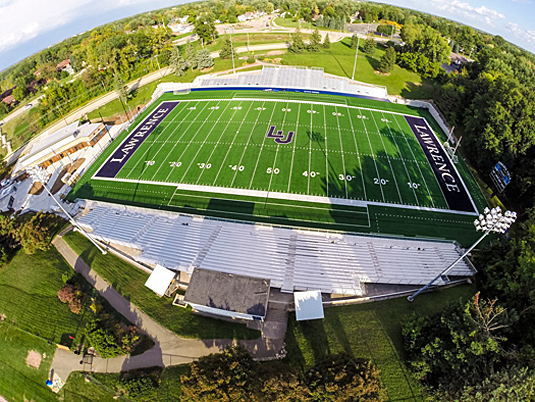Lawrence University’s Banta Bowl has always been a home to winners, but the facility itself is now a winner as well.
The recently renovated Ron Roberts Field at the Banta Bowl has received an award from the American Sports Builders Association (ASBA). The new-look Banta Bowl, designed by Rettler Corp. of Stevens Point and constructed by The Boldt Co. of Appleton, was honored in the Distinguished Field Facilities category.

“It is exciting to be honored with this award,” Lawrence Director of Athletics Christyn Abaray said. “The foresight and vision displayed to show what this could be, and the deliberation and expertise utilized to make the Banta Bowl a reality are commendable and remarkable. We want to thank everyone who supported and continue to support this effort. This is an example of how impactful positive change can be.”
The ASBA, the national organization for builders and suppliers of materials for athletic facilities, presents these awards annually to facilities built by ASBA members and exemplify construction excellence.
The 3,634-seat Banta Bowl, tucked into a natural ravine just south of the Fox River, underwent the major renovation during the spring and summer of 2015.
Renovations began with raising and widening the playing field to accommodate a soccer pitch. The stadium, home to Lawrence football since 1965, now also houses the Lawrence men’s and women’s soccer teams. The natural grass surface was replaced with FieldTurf to allow for more and varied use of the stadium.
The fan experience was greatly improved with aluminum grandstand seating and an LED scoreboard that houses a new sound system.
Fans enter the Banta Bowl through an inviting plaza at the north end of the stadium. The new Gilboy Athletic Center houses Lawrence’s football locker room, an athletic training room, an officials’ room, concessions, ticketing and restrooms. The building was named for Steve ’62 and Joan Gilboy, who provided a leadership gift for the stadium renovation.
The naming of Ron Roberts Field at the Banta Bowl honors Lawence’s legendary football coach and long-time director of athletics, Ron Roberts, at the behest of Tom Rogers ’65, who gave the lead gift for the renovation.
Lawrence surpassed the goal of $4.5 million to renovate the stadium, and the final piece of the renovation is set to be completed in 2017. The original press box will be replaced with a new multi-level facility for game control personnel, the media and coaches. It is expected to be ready for games in the fall of 2017.
“This was an incredibly collaborative endeavor that bore a result of which all involved can be very proud,” Abaray said.
“Thanks to the leadership of Lawrence for this project from the Board of Trustees, President Mark Burstein and Vice President for Alumni and Development Cal Husmann,” Abaray added. “In addition, thank you to Mike Szkodzinski, director of athletics/head hockey coach at the time of planning and construction, and Rettler Corporation for their significant contribution to the renovation. Finally, thank you to Lynn Hagee, instrumental in the aesthetic appeal of the Banta Bowl, for her assistance.”
The football teams at Lawrence have embraced the Banta Bowl and made it a home to champions. The Vikings, under the leadership of Roberts, captured seven of their 16 Midwest Conference titles since moving into the stadium in 1965.
The Banta Bowl would not have been possible without the generosity of George Banta Jr. ’10. Originally called the Lawrence Bowl, the stadium was an anonymous gift from Banta and was renamed in his honor after his death in 1978.
About Lawrence University
Founded in 1847, Lawrence University uniquely integrates a college of liberal arts and sciences with a nationally recognized conservatory of music, both devoted exclusively to undergraduate education. It was selected for inclusion in the book “Colleges That Change Lives: 40 Schools That Will Change the Way You Think About College.” Engaged learning, the development of multiple interests and community outreach are central to the Lawrence experience. Lawrence draws its 1,500 students from nearly every state and more than 50 countries.